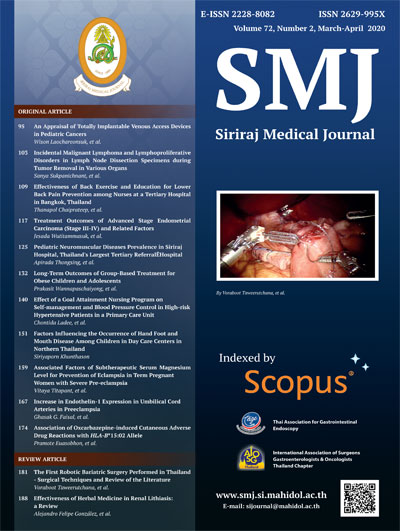Long-Term Outcomes of Group-Based Treatment for Obese Children and Adolescents
DOI:
https://doi.org/10.33192/Smj.2020.18Keywords:
Obese; child; adolescent; group-based treatment; outcomeAbstract
Objective: A 1-year, group-based, treatment program with parental involvement was conducted on 115 obese youths during 2006-2011. The intervention decreased obesity severity. The current study assessed the participants’ long-term weight loss and obesity-related complications.
Methods: Participants were invited for a single visit. Their weights, heights, and waist circumferences were measured and compared with corresponding figures at group-based treatment program completion. Factors associated with changed percentage weight-for-height (%W/H) were assessed.
Results: There were 43 subjects, including 6 participating telephonically. The median follow-up duration was 5.8 years. %W/H, BMI, and waist circumference increased significantly (p = 0.012, 0.002, and 0.003, respectively). %W/H rose for 26 participants (60.5%; failed group) but declined or stabilized for 17 (39.5%; successful group). The successful-group exercise duration and frequency were significantly higher (p = 0.006 and 0.018, respectively). Three participants had type 2 diabetes, including 1 known case, all in the failed group. Newly-found obesity-related disorders were elevated transaminases (6 participants, with 5 from the failed group), elevated blood pressure (1 failed-group participant), and dyslipidemia (one from each group).
Conclusion: Only 40% of the participants maintained long-term weight reduction. Regular exercise was associated with successful weight maintenance. Obesity-related complications were common in the failed group.
References
2. Daniels SR, Arnett DK, Eckel RH, Gidding SS, Hayman LL, Kumanyika S, et al. Overweight in children and adolescents: pathophysiology, consequences, prevention, and treatment. Circulation 2005;111:1999-2012.
3. Bjorge T, Engeland A, Tverdal A, Smith GD. Body mass index in adolescence in relation to cause-specific mortality: a follow-up of 230,000 Norwegian adolescents. Am J Epidemiol 2008;168:30-7.
4. Styne DM, Arslanian SA, Connor EL, Farooqi IS, Murad MH, Silverstein JH, et al. Pediatric Obesity-Assessment, Treatment, and Prevention: An Endocrine Society Clinical Practice Guideline. J Clin Endocrinol Metab 2017;102:709-57.
5. Barlow SE, Expert C. Expert committee recommendations regarding the prevention, assessment, and treatment of child and adolescent overweight and obesity: summary report. Pediatrics 2007;120 Suppl 4:S164-92.
6. Santiprabhob J, Leewanun C, Limprayoon K, Kiattisakthavee P, Wongarn R, Aanpreung P, et al. Outcomes of group-based treatment program with parental involvement for the management of childhood and adolescent obesity. Patient Educ Couns 2014;97:67-74.
7. Reinehr T, Temmesfeld M, Kersting M, de Sousa G, Toschke AM. Four-year follow-up of children and adolescents participating in an obesity intervention program. Int J Obes (Lond) 2007;31:1074-7.
8. Moens E, Braet C, Van Winckel M. An 8-year follow-up of treated obese children: children's, process and parental predictors of successful outcome. Behav Res Ther 2010;48:626-33.
9. Adam S, Westenhoefer J, Rudolphi B, Kraaibeek HK. Three- and five-year follow-up of a combined inpatient-outpatient treatment of obese children and adolescents. Int J Pediatr 2013;2013:856743.
10. Keane V. Assessment of growth. In: Kliegman RM, Stanton BF, St Geme III JW, Schor NF, Behrman RE, editors. Nelson textbook of pediatrics. 20th ed. Philadelphia: Elsevier; 2016. p. 84-9.
11. Reinehr T, Kleber M, Toschke AM. Lifestyle intervention in obese children is associated with a decrease of the metabolic syndrome prevalence. Atherosclerosis 2009;207:174-80.
12. Reinehr T, Brylak K, Alexy U, Kersting M, Andler W. Predictors to success in outpatient training in obese children and adolescents. Int J Obes Relat Metab Disord 2003;27:1087-92.
13. Adam S, Westenhofer J, Rudolphi B, Kraaibeek HK. Effects of a combined inpatient-outpatient treatment of obese children and adolescents. Obes Facts 2009;2:286-93.
14. Castelnuovo G, Pietrabissa G, Manzoni GM, Cattivelli R, Rossi A, Novelli M, et al. Cognitive behavioral therapy to aid weight loss in obese patients: current perspectives. Psychol Res Behav Manag 2017;10:165-73.
15. Mirza NM, Palmer MG, Sinclair KB, McCarter R, He J, Ebbeling CB, et al. Effects of a low glycemic load or a low-fat dietary intervention on body weight in obese Hispanic American children and adolescents: a randomized controlled trial. Am J Clin Nutr 2013;97:276-85.
16. Donnelly JE, Greene JL, Gibson CA, Smith BK, Washburn RA, Sullivan DK, et al. Physical Activity Across the Curriculum (PAAC): a randomized controlled trial to promote physical activity and diminish overweight and obesity in elementary school children. Prev Med 2009;49:336-41.
17. Han JC, Lawlor DA, Kimm SY. Childhood obesity. Lancet 2010;375:1737-48.
Downloads
Published
How to Cite
Issue
Section
License
Authors who publish with this journal agree to the following conditions:
Copyright Transfer
In submitting a manuscript, the authors acknowledge that the work will become the copyrighted property of Siriraj Medical Journal upon publication.
License
Articles are licensed under a Creative Commons Attribution-NonCommercial-NoDerivatives 4.0 International License (CC BY-NC-ND 4.0). This license allows for the sharing of the work for non-commercial purposes with proper attribution to the authors and the journal. However, it does not permit modifications or the creation of derivative works.
Sharing and Access
Authors are encouraged to share their article on their personal or institutional websites and through other non-commercial platforms. Doing so can increase readership and citations.















